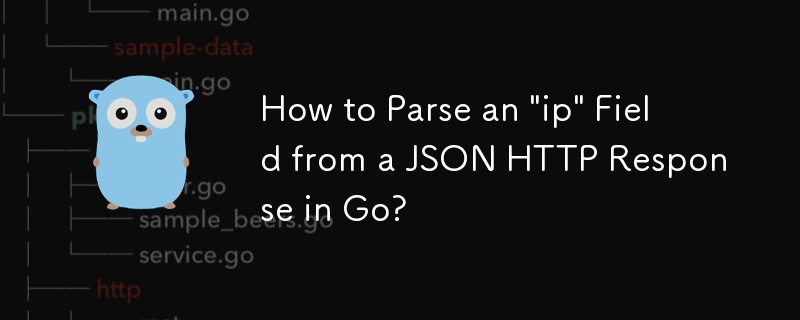如何在 Go 中解析 JSON HTTP 回應中的「ip」欄位?
- Linda Hamilton原創
- 2024-11-27 12:59:13467瀏覽

在Go 中解析JSON HTTP 回應
在本文中,我們將解決一個常見的編碼挑戰:在Go 中解析來自HTTP請求的JSON 回應Go 程式語言。我們將透過一個範例來幫助您破解回應並提取特定值,例如「ip」欄位。
以以下curl 輸出為例:
{
"type":"example",
"data":{
"name":"abc",
"labels":{
"key":"value"
}
},
"subsets":[
{
"addresses":[
{
"ip":"192.168.103.178"
}
],
"ports":[
{
"port":80
}
]
}
]
}
我們的目標是從此回應中擷取「ip」欄位的值。
結構為基礎的 JSON解碼
為了解碼 JSON 回應,我們將建立鏡像 JSON 結構的結構。 Go 中的結構體充當我們資料的模板,定義其形狀和欄位。
以下範例程式碼示範了基於結構體的JSON 解碼:
type Example struct {
Type string `json:"type,omitempty"`
Subsets []Subset `json:"subsets,omitempty"`
}
type Subset struct {
Addresses []Address `json:"addresses,omitempty"`
}
type Address struct {
IP string `json:"IP,omitempty"`
}
func main() {
jsonResponse := `{
"type": "example",
"data": {
"name": "abc",
"labels": {
"key": "value"
}
},
"subsets": [
{
"addresses": [
{
"ip": "192.168.103.178"
}
],
"ports": [
{
"port": 80
}
]
}
]
}`
r := bytes.NewReader([]byte(jsonResponse))
decoder := json.NewDecoder(r)
val := &Example{}
err := decoder.Decode(val)
if err != nil {
log.Fatal(err)
}
for _, s := range val.Subsets {
for _, a := range s.Addresses {
fmt.Println(a.IP)
}
}
}
解碼特定金鑰
在上面的程式碼中,我們使用一個名為Example 的結構來匹配JSON 回應的結構。使用解碼器,我們可以將回應解碼為範例結構。
為了提取「ip」值,我們存取位址切片,它是位址結構的切片。每個 Address 結構體都包含“ip”字段,允許我們列印它的值。
透過以下步驟,您可以在 Go 中有效解析 JSON HTTP 回應並檢索特定的資料值,例如中的「ip」欄位這個範例。始終記住創建與 JSON 結構相符的結構,並使用解碼器以回應資料填充它們。
以上是如何在 Go 中解析 JSON HTTP 回應中的「ip」欄位?的詳細內容。更多資訊請關注PHP中文網其他相關文章!
陳述:
本文內容由網友自願投稿,版權歸原作者所有。本站不承擔相應的法律責任。如發現涉嫌抄襲或侵權的內容,請聯絡admin@php.cn

